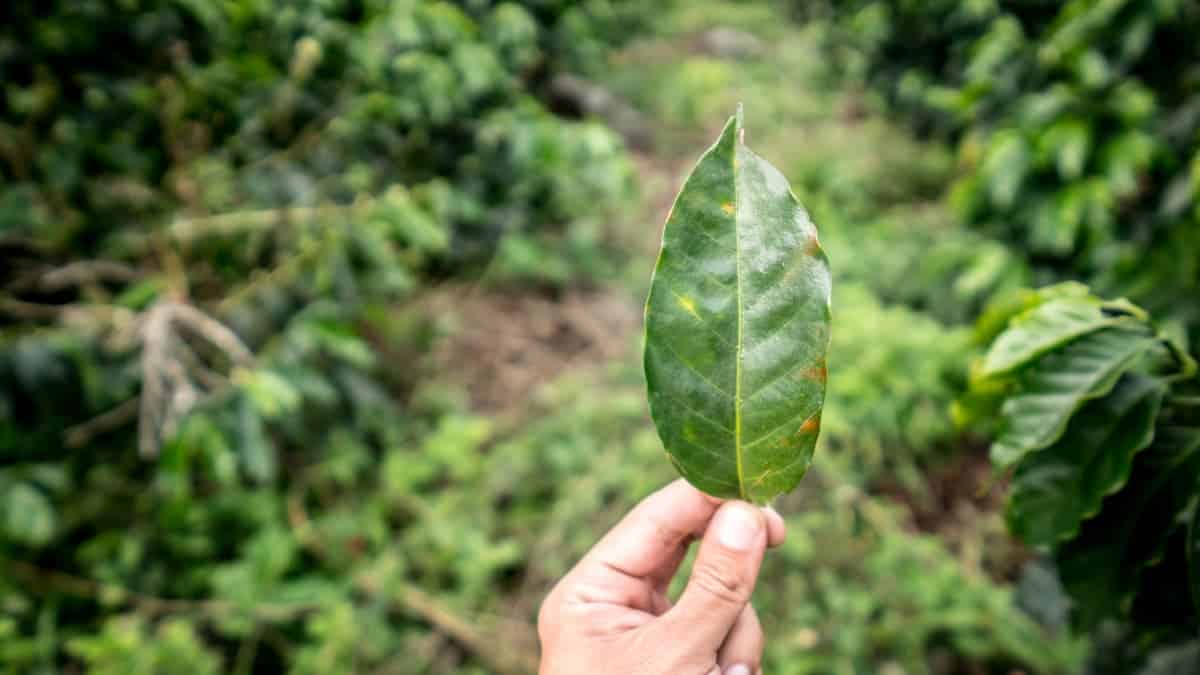Coffee Leaf Rust: A Nightmare Crop Disease
The coffee industry faces a silent and devastating threat. That threat, coffee leaf rust, could destroy the livelihoods of millions of people who depend on coffee.
Coffee leaf rust is a plant disease that few people have heard of. But coffee growers around the world are well-aware of the problem, and they are waging a constant war against it.
Why has this disease created havoc around the world? How will it affect the coffee we drink? And what are farmers doing to protect themselves – and our beloved beverage?

What Is Coffee Rust Disease?
The coffee industry is worth about US$ 100 billion per year. Threatening an entire industry and the traditional way of life of the millions of people who produce coffee is coffee rust. This infection has been threatening – and destroying – coffee crops for well over a century.
So what is it?
Coffee rust is the common name for a fungus that goes by the scientific name of Hemileia vastatrix. When the disease attacks a coffee farm, the farmer might first notice a yellowish spot on the leaves of a coffee plant.
Another spot then forms on coffee leaves and eventually combines with others. The spots begin to produce spores that look like a powder, ranging in color from orange to brown. Finally, the coffee leaves turn brown or black and fall off the tree.
As you can see, coffee rust doesn’t kill the coffee tree itself. It simply attacks the leaves. The problem is that with no leaves there’s no photosynthesis, and the plant doesn’t receive the nutrients it needs.
The weakened plant can no longer produce the same amount of cherries. Over time, the plant stops producing cherries altogether. And no coffee cherries means no coffee beans.
It’s an unfortunate flywheel that keeps turning. From Sri Lanka to El Salvador, it’s now a global problem.
Coffee Rust Origins
Coffee rust became famous (or rather infamous) in Sri Lanka in the 1860s. At that time, vast coffee plantations covered the country. In a matter of decades, the rust destroyed entire plantations of coffee crops in Sri Lanka as well as neighboring countries.
But, the disease was already known back then, having been documented on the other side of the world where coffee originates from – Ethiopia. There, thousands of varieties of wild coffee trees co-existed in the forest. The biological diversity of those wild coffee plants protected them from infection.
Coffee rust that would affect one variety wouldn’t jeopardize the variety growing next to it, and so it wouldn’t spread.
The biological diversity that minimized infection for centuries in Africa ceased to exist when coffee began to be planted as a cash crop. As coffee began to be planted in monocrops with just one variety, it became susceptible to infection.
Coffee rust spread slowly out from Sri Lanka to India. By the 1920s, it had covered much of Asia. Then in the 1950s, another outbreak occurred as the disease traveled back to Africa.
It was in the late 1960s that coffee rust crossed the Atlantic and spread to South America. It first landed in Brazil, then spread to Colombia. From there it was a short jump to countries in Central America. Within a decade, it had covered the Americas and the Caribbean.

How Coffee Rust Spreads
Coffee rust spreads quickly and is nearly impossible to contain. Environment plays a significant role in spreading the fungus. While international travel once impacted its spread, currently, the most significant factors are wind and water.
The spores of the fungus ride the wind to new territories and infect plants. In that way, coffee rust spores are passed from country to country.
Coffee rust thrives in wet, humid environments – those same environments that help coffee trees also to thrive. Rainwater splashing on the leaves contributes to the spread of the spores from tree to tree.
Another factor is plant genetics. Certain coffee species and varieties are naturally resistant to coffee rust.
Coffea Canephora, more commonly known as Robusta, is one of those. Since the taste of Robusta coffee is generally less appreciated, this species has not been as popular among coffee drinkers, except mainly in Vietnam.
About 70% of the world’s coffee is Coffea Arabica, a species that is not as resistant to coffee rust. That means that most of the coffee in the world is at least partially susceptible.
Later on, in the article, we’ll talk about what’s being done in this field to make coffee more disease-resistant yet still tasty.

Coffee Production & Economic Impact
Coffee rust epidemics can wipe out the entire coffee production in a country, leaving millions of people – mostly vulnerable farmers – out of work. It can even destroy the economy of a country.
When a disease means your income will be wiped out, terror strikes deep.
That terror struck Latin America in a coffee rust outbreak that started in 2012. It affected Mexico all the way to Peru, including part of the Caribbean. In just two years, that coffee rust outbreak affected up to 80% of all coffee produced. The loss amounted to 2.7 million 60-kilo bags. Suddenly, 1.7 million people were out of work, mostly in Central America.
In the last 50 years, coffee rust epidemics have become more common and devastating. Globally, they cause losses of US$ 1-2 billion every year in the coffee world.
A lower coffee yield around the world creates shortages in supply. That makes coffee prices shoot up for consumers. Even worse, coffee growers lose their means to provide for their families.
Adding to this challenge is climate change. Rising temperatures and increased moisture due to heavy rains played a role in the 2012-2013 crisis in Latin America. As conditions worldwide become warmer and humidity continues to increase, coffee producers find it a challenge to keep their crops free from coffee rust.
High-altitude producers once felt safe from this kind of parasite due to cooler conditions on their farms. Now they also face this enemy.
There is no cure for coffee rust. The best approaches to managing coffee rust have to do with avoiding outbreaks. What are coffee growers doing to reduce the impact of coffee rust on their crops?

Disease Management Practices
Once coffee rust is present in an area, containment can be nearly impossible. Therefore, the efforts of growers come down to two objectives:
• They can prepare in advance by planting species that are resistant and by using optimal farm management techniques.
• After an outbreak has started in their area, they can attempt to contain it using measures such as fumigating and quarantine.
Early warning management
A mix of the two approaches, early warning management can help a producer take action as the threat approaches. Part of early warning management is educating coffee growers about the long-term risks of coffee rust and how they can do more to protect their crops.
Governmental organizations, national coffee associations, and growers associations can work together to identify regional outbreaks and risk conditions. Then they notify coffee growers in those areas and provide education and aid so they can implement changes such as the ones listed below.
For early warning management to be effective, advance action and good communication are necessary. Getting all coffee growers on board in the fight against coffee rust is essential. Many governmental agencies and coffee cooperatives help get the word out about coffee rust and how growers can protect themselves.
Disease resistant varieties
Colombia, in South America, has depended on coffee export for decades. Back in the 1960s, they saw the looming threat of coffee rust. Since only Arabica coffee can be exported from this country, the threat for them was even larger there than in Brazil.
The National Coffee Growers Federation took swift action and started to develop coffee varieties that are resistant to coffee rust. Now, 83% of Colombian coffee farms minimize the threat of coffee rust just by the type of coffee varieties they plant.
Those Arabica varieties that are resistant to coffee rust contain Robusta genetics. What do they try to achieve with these varieties? The goal is to combine the rust resistance of Robusta and its ability to endure higher temperatures while preserving Arabica’s great taste in the cup.
As amazing as these varieties can be, the reality is that it’s expensive for a coffee producer to remove old coffee trees from their farm and plant new ones. Even a small farm has tens of thousands of coffee trees.
Also, it can take up to three years before coffee plants reach a stage where they’re producing for commercial use. Waiting that time can be impossible for small-scale farmers who depend on every tree. In some countries, crop replacement is subsidized by the government or other agencies.

Crop management
How crops are managed can have a huge effect on the incidence of coffee rust. Coffee farmers can experiment by using proper shade, farm structure, weed control, and nutrition.
When coffee trees are planted in a structured way and weeds are controlled, growers can manage excess moisture. Good nutrition contributes to healthy coffee plants that can more effectively resist coffee rust. Avoiding monocultures also helps.
Coffee growers can use more than one coffee variety. Growers can also use more plants and shrubs that act as a natural barrier to the spread of coffee rust. Many of these other plants are also used to feed the family or for income, such as citrus trees, bananas, and avocados.
Chemical control
One way to control fungal diseases is through fungicides and pesticides. However, fungicides can be expensive for small-scale growers. They may also have damaging consequences on their own health, consumers’ health, and the environment. That’s why growers who use fungicides may not be eligible for organic certification.
Biological control can use the natural enemies of coffee rust to keep it in check. Parasitic fungi that eat other parasites (called hyperparasites) can help eliminate the coffee rust fungus. Unfortunately, these biocontrol methods are still in the research stage and are not available for use.
Copper fungicides are used to eliminate coffee rust. One limitation with copper fungicides is they need to be applied to plants before an outbreak occurs – which is not always possible. Also, there are serious concerns about the accumulation of copper in the soil, which can be toxic at certain levels.
Quarantine
When plants get infected with coffee rust, farmers can use quarantine methods to protect the other farms in the area. The most effective quarantine measures include destroying the infected plants and spraying herbicides in a wide area.
These techniques were more effective in the past. As coffee rust has spread around the world, it becomes more challenging to contain it. Additionally, since coffee rust spreads fast on the wind, these quarantine measures aren’t always effective.
What does coffee rust mean for you?
As you can see, implementing these changes on farms requires government action, community education, and resources. That involves the whole supply chain, from growers to consumers. But how can coffee lovers help in this fight against coffee rust?
When coffee farmers are paid a fair wage for their crops, they can invest in their farms. What’s a fair wage? When they are paid enough to cover the costs of production, including labor and materials. They can then invest by replacing older coffee crops, improving farm structure, and maintaining good hygiene.
Then the farms will be stronger to resist the next attack of coffee rust.
Our role as consumers is to make sure that our purchases benefit everyone along the chain, including the grower. Ethical companies are transparent about how they pay their producers.
When consumers appreciate the value of better coffee that improves living conditions for everyone, each purchase they make enhances the world of coffee.

